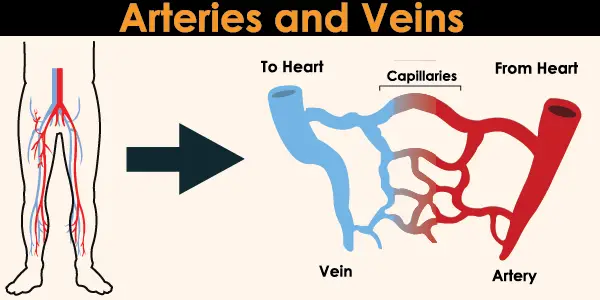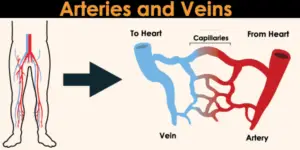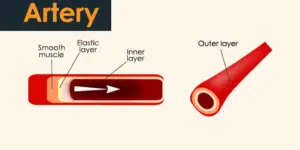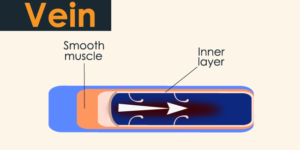
Difference between arteries and veins
The very basic difference between Arteries and Veins is that arteries contribute to supply the oxygenated blood from the heart to the rest of the body parts while veins contribute to supply the deoxygenated blood from body parts back to the heart. The arteries are red in color while the Veins are blue.

Difference between Arteries and Veins in tabular form :
|
Arteries. |
Veins. |
|
| 1. | Carries oxygenated blood which is rich in nutrients and oxygen as well. | Carries deoxygenated blood which lacks oxygen and can also be known as impure blood. |
| 2. | Deeply situated within the body. | Situated close to the skin (as you can see in arms). |
| 3. | Red in color. | Blue in color. |
| 4. | Possess rigid, thicker, and highly muscular walls. | Possess thin and soft walls. |
| 5. | Supply blood from cardiac muscle (heart) to various body parts. | Supply blood from various body parts back to cardiac muscle. |
| 6. | Possess a narrow lumen (diameter in the pipe). | Possess a wide lumen. |
| 7. | Have a high-pressure flow of blood in them. | Possess a low-pressure flow of blood. |
| 8. | It contains a lower blood volume of around 15% of the body’s blood. | It contains a higher volume of blood which is around 65% of the whole body. |
| 9. | In comparison to veins, arteries Have high oxygen and low carbon dioxide. | Have low oxygen and high carbon dioxide. |
| 10. | Arteries Possess no valves | Possess valves to allow blood flow upward from the lower body. |
| 11. | It can be at greater risk of diseases like Angina Pectoris and Atherosclerosis because of the presence of oxygen (oxygen allows micro-organisms to survive). | At the lower risk of diseases but can also acquire a few like Varicose Vein. |
| 12. | Arteries get empty at the time of death | At the time of death, these get filled up. |
| 13. | The thickest layer that is present in arteries is ‘tunica media’. | Tunica adventitia’ is the thickest layer considered |
| 14. | The contraction of the muscle is present in arteries. | The contraction is absent in veins. |
| 15. | Types of arteries are systematic and pulmonary. | Systematic, pulmonary, deep, and superficial are the types of veins. |
Definition of Artery
The artery is defined as a blood pipeline or vessel that conveys oxygenated blood from the heart to rest of the body tissues, organs, or body parts. Arteries are muscular tubes lined up by smooth tissues and are a part of the circulatory system employed to convey oxygen and nutrient-rich blood to body tissues.

What Are The Types of Arteries:
There are three types of arteries known which are:
- Muscular arteries.
- Elastic Arteries.
- Arterioles.
Muscular Arteries: These are muscular in such a way that the walls of these arteries are lined up with muscle fibers that are responsible for the characteristic these arteries have to contract and relax.
Muscular arteries somehow rely on elastic arteries as elastic arteries are responsible for the blood supply in the muscle fibers that are present in the walls of muscular arteries.
Elastic Arteries: These types of arteries are considered large vessels that are just coming out of the heart as the aorta and pulmonary artery, these are also known types of elastic arteries.
These are flexible as the name tells, have the ability to vacuum the blood out to keep the circulation moving around. These have the elastic characteristic due to the protein present in there known as elastin.
Arterioles: These are considered the smallest artery type that serves to branch out blood from large arteries to the capillary network
Definition of the vein:
The vein is defined as the vessel or pipeline that carries back the blood from the rest of the body to the heart. The blood that it carries back to the heart is now deoxygenated because the oxygen it has before is utilized by the body tissues and now it is going back to heart to get itself utilized.
Veins possess less muscle and are thinner than arteries but overall basic makeup of both is the same.

What are the types of veins?
Majorly these Veins are categorized into two types which are:
- Systematic veins.
- Pulmonary Veins.
However, there are some scientists who further classify systematic veins into three more subtypes, which are:
- Deep veins.
- Superficial veins.
- Connecting veins.
Deep veins: These are considered the subtype of systematic veins that posses a corresponding artery and are exist in the muscle tissue.
Superficial veins: These veins are considered as the nearest to the skin layer and do not have a corresponding artery present.
Connecting veins: These are the 3rd subtype of systematic veins that are employed to allow blood flow from the superficial to deep veins.
Similarities between arteries and veins
| 1. |
Both are blood vessels and are part of the circulatory system.
|
| 2. | Both are blood transporters. |
| 3. | Both are majorly composed of three layers which are tunica adventitia, tunica media, the tunica intima. |
| 4. | Both are muscular layers that are responsible for relaxation and contraction |
| 5. | Both are cardiac associated. |
Aifference between arteries and veins anatomy
there are three major layers in arteries and veins:
- Tunica adventitia.
- Tunica media.
- Tunica intima.
Tunica adventitia: the external covering of vessels that consists of proteins like elastin and collagen. the covering enables the vessel to contract and relax. the characteristic of getting the contract and relax is to manage blood pressure.
Tunica media: the middle lining of the vessel that is composed of the elastin and muscle fiber. the ratio of the amount of muscle fiber and elastin protein in the layer depends on the type of the vessel.
Tunica intima: the inner blood vessel lining is called tunica intima that the composition of which is divided into the tissue, elastic membrane, and also sometimes include valves that assist blood flow in the appropriate direction.
Why pressure is higher in our arteries than in our veins?
You just have to remember that all the pressure in our blood vessels is created when the heart pumps and expels out the blood while systole. The arteries subdivide until they form capillaries where the nutrients exchange takes place. These capillaries are flexible due to which some of the pressure is absorbed by their flexibility. More the distance from the heart, less will be the pressure.
In short, these large vessels split into millions of tiny vessels, due to which pressure in these vessels is low. Coming further ahead these vessels converge in relatively low-pressure veins.
Oxygenated and De-oxygenated Blood:
Our body’s blood stream possesses two types of blood Oxygenated and De-oxygenated blood. Oxygenated blood is rich in oxygen while de-oxygenated blood lacks oxygen.
We can also say it in such a way that de-oxygenated blood carries more carbon dioxide which is going to be kicked out from the body through exhalation and oxygenated blood carries more oxygen which is going to be delivered to the rest of the body cells, tissues and organs. Remember, cells join together and make tissues and tissues make organs (Cells > Tissues > Organs).
If we talk about the visual appearance of these two types of blood then oxygenated blood is of bright red color while de-oxygenated is of dark red to bluish in color. Oxygenated blood always travels in arteries from the heart to the rest of the body. Deoxygenated blood always travels in veins that’s why it is also called venous blood and it travels always from the rest of the body to the heart.
Conclusion:
After going through the above article we can now conclude that there are tons of differences between arteries and veins and these are few of them. These are major participants in the circulatory system as one of them works to push blood away from the heart and one work to push back the blood to the heart.
FAQ
What is deoxygenated blood?
Simple, the blood that possesses no oxygen in it is called as deoxygenated blood and it is carried by veins from the body back to the heart to be oxygenized.
What is oxygenated blood?
The blood that possesses oxygen in it is called as oxygenated blood. It is carried by the arteries from the heart to rest of the body.
What is the color of oxygenated and deoxygenated blood?
Both are red in color but the oxygenated blood is bright red in color while the deoxygenated blood looks dark red in color.
What is the color of arteries?
Arteries possess red color and are situated deep in the body.
What is the color of veins?
Veins possess blue color and are situated close to the skin layer.
Who discovered that arteries carry blood?
Willian Harvey is the scientist who discovered that the arteries carry blood.
What is the major difference between arteries and veins?
Arteries are employed to supply the oxygenated blood from the heart to the rest of the body tissues while veins contribute to supply the deoxygenated blood from body parts back to the heart.